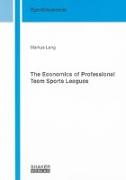- Start
- The Economics of Professional Team Sports Leagues
The Economics of Professional Team Sports Leagues
Angebote / Angebote:
This book contains a collection of four independent research papers on the economics of professional team sports leagues.
In Chapter 2 we will present a basic model of talent investment in a team sports league. This model may give the reader a deeper understanding of the associative character of competition. No team can improve its position in the standings without worsening the position of other teams. Since sporting and economic success are usually correlated, this rank order contest may result in destructive competition. Our analysis can explain why clubs are caught in a typical prisoners' dilemma type of equilibrium and why clubs tend to 'overinvest' in playing talent. The model will incorporate typical features of team sports leagues such as an endogenous league prize, additional exogenous prizes and a system of promotion and relegation.
In Chapters 3 and 4 we will extend our analysis by incorporating with the clubs and the players also the consumers (fans). We will derive fan demand from a general utility function by assuming that a fan's willingness to pay depends on the quality of the match/league. This approach will enable us to provide a full-fledged welfare analysis of a sports league. In Chapter 3 we take the currently intensive discussions of the leading European football clubs to introduce salary caps as a motivation to analyze their welfare effects. Financial disparity and spiralling wages have triggered this debate in Europe. Using a game-theoretical model of a league consisting of both small- and large-market clubs we will investigate the effect of salary caps on competitive balance, the aggregate salary payments and social welfare. In Chapter 4 we analyze the welfare effect of one of the most common means of redistribution in a sports league - gate revenue-sharing. In its simplest form, gate revenue-sharing allows the visiting club to retain a share of the home club's gate revenues. By means of a contest model with two asymmetric clubs, we will analyze the effect of alternative gate revenue-sharing arrangements on the investment behavior, competitive balance, club profits and social welfare.
In Chapter 5 we turn our attention towards the labour-market of the European football leagues and will analyze the role of transfer restrictions. Transfer restrictions have a long tradition in professional football, but have come under heavy attack in recent years. The transfer system imposed by the football governing bodies on employment relations made sure that a player could not leave his current club and sign with another club without the current club's explicit consent. The 1995 Bosman judgement of the European Court of Justice, declaring football players to be free agents after expiration of their contracts, and the 2001 intervention of the European Commission, which, among other things, limited contract durations in football, can be interpreted as the two major steps towards restricting the application of the transfer system. We will develop a theoretical model which captures an important and widely overlooked aspect of the employment relation in professional football: the allocation of risk. Players and clubs alike do not know how the productivity of a player will develop in future periods. If risk is the key driver behind the performance uncertainty of football players then there is a potential for value creation in this industry. Risk-averse players could buy insurance against future income uncertainty when contracting with risk-neutral clubs. Our model will analyze whether risk-averse football players really benefit from less restrictive transfer systems.
The book concludes in Chapter 6 with a short discussion and a summary of the main results.
Libri-Titel folgt in ca. 2 Arbeitstagen
